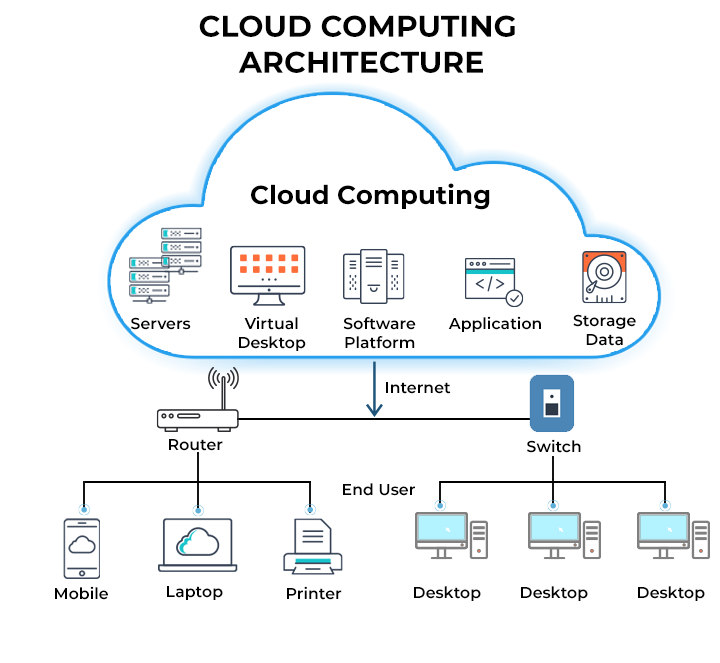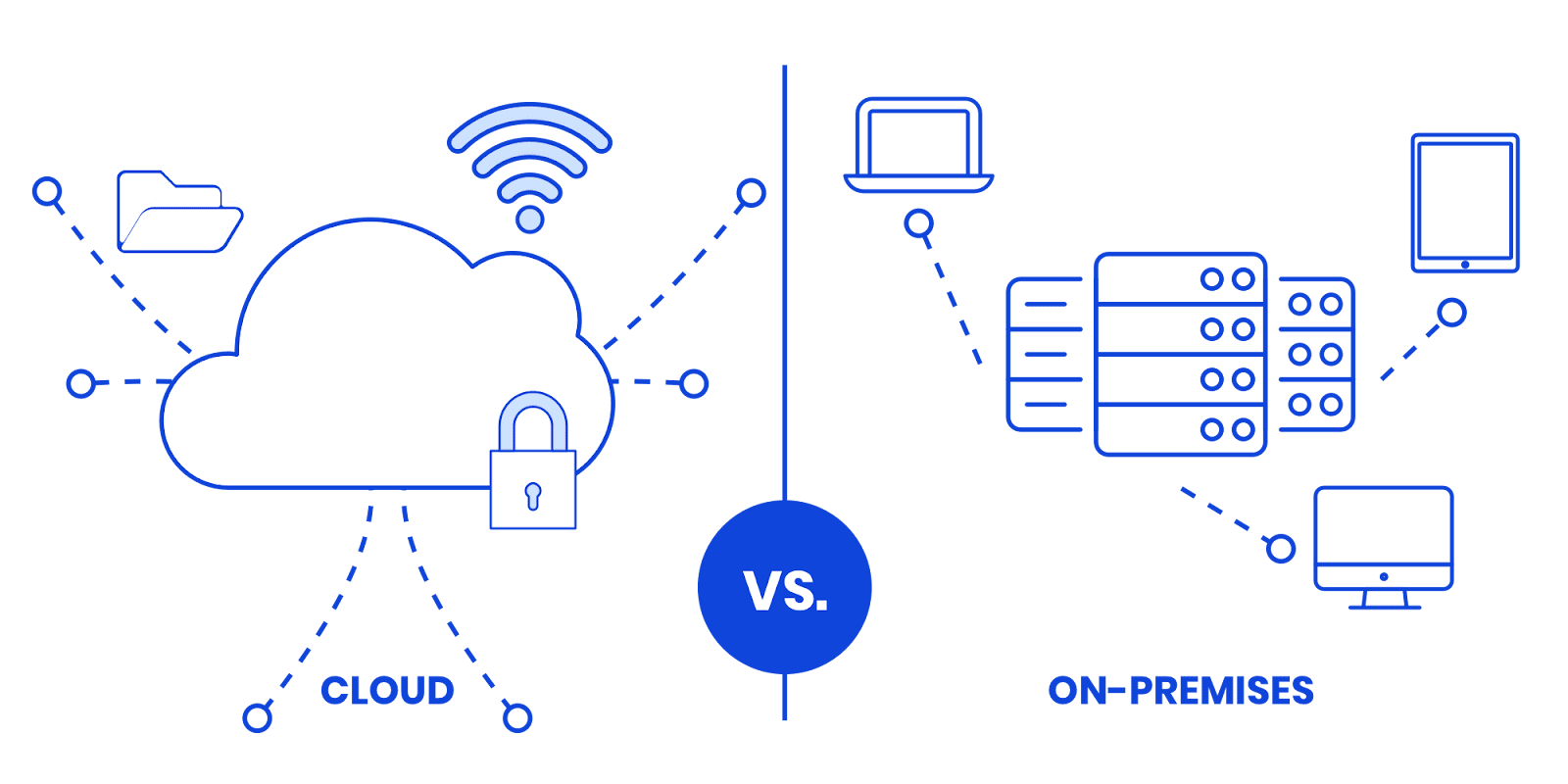It won’t come as a surprise that the pandemic has changed the way we do business.
More businesses moved their products and services online due to physical COVID-related restrictions over the last few years. But there are still many organizations out there that aren’t quite ready to take the leap to a fully cloud-based solution. Businesses in the banking and government space, or those with particular compliance and security needs, may prefer to keep some of their crucial applications managed on-premise. As a result, research shows that hybrid cloud strategies are on the rise with higher-than-expected cloud usage.
As you are faced with having to change tack to keep up with demand and stay ahead of the game in your industry? How do you know what option is best for your business? Are you better off with an on-premise solution, a hybrid solution, or migrating all your systems, applications, and data to the cloud?
To help make that decision a little easier, we’ll compare the key differences between on-premise and cloud, including cost, security, and more. But let’s start by explaining the different terms.
Related: How to integrate legacy systems
What Is Cloud Computing?
Do you write in Google Docs? Do you communicate with your team members via Slack or Teams? If you do, you’re working in the cloud. Accessing and storing data on the internet is the key to cloud computing. It means you can get to your data and use applications from wherever you are.
There are three different models: IaaS (Infrastructure-as-a-Service), PaaS (Platform-as-a-Service), and SaaS (Software-as-a-Service). SaaS is application software hosted in the cloud, accessible via the Internet or an API. PaaS provides an on-demand platform to software developers, so they don’t have to manage, develop, or run applications on an on-premise platform. And last, but not least, IaaS provides on-demand access to servers, networks, and storage on a pay-as-you-go basis.

What Is an On-Premise System?
We’ve all received an email once in a while about software licenses at work being reviewed and subsequently upgraded or downgraded. Those software applications you use, like perhaps the Adobe suite or your organization’s accounting software, are being stored on your business’s servers. So what does on-prem mean? Exactly that—on-premise, or locally stored. An on-premise system retains all its processes, services, and data on local servers within your organization.
Your IT team is responsible for maintenance, security, deployment, future-proofing, and anything else that the on-premise systems require to make them suitable for the business’s needs and changing requirements. A benefit of keeping systems on-premise is complete control—over everything from cost, access, and deployment to security, compliance, and improvements—but the downside is that the upkeep of all applications and systems can be very labor-intensive.
Related: An overview on cloud-to-cloud integration
What Is a Hybrid Cloud Environment?
If you store some of your data and applications on-premise, while others are in the cloud, you’ve got yourself a hybrid cloud environment. This approach integrates public cloud services, private cloud services, and on-premise infrastructure to provide a flexible, distributed computing solution tailored to an organization’s needs.

For example, your organization may have some of its major data applications such as accounting systems or customer databases hosted on-premise, while cloud-based software such as Teams or Slack is used for remote communication between employees. Some of the benefits of a truly hybrid cloud are:
Higher Developer Productivity
Instead of developing code and software, and having to deploy to each instance individually, a hybrid cloud platform enables teams to develop and deploy to the cloud at once. Agile and DevOps methods are also easier to incorporate in a hybrid cloud environment.
Better Infrastructure Efficiency
Teams can optimize the time spent across different cloud services (private and public) and vendors. Applications can be optimized faster and data connected to cloud and on-prem services more efficiently if applications are integrated.
Improved Security and Compliance
You can pick the best-of-class security and compliance technologies and consistently implement them across all your environments.
Business Growth
A hybrid cloud environment allows for shorter product development cycles, increased innovation, faster time-to-market, and delivery of applications.
Research has shown companies gain up to 2.5 times the value from a hybrid multi-cloud (meaning the organization uses more than one public cloud provider) compared to a single-cloud, single-vendor approach.
Related: What is a one-way sync? And how can you use it?
Key Differences Between On-Premise and Cloud
In addition to the foundational differences between on-premise and cloud, there are other aspects to take into account before making a decision on which suits your business best. There isn’t a one-size-fits-all approach, and what is best for your organization comes down to many different factors.
Let’s run through the pros and cons of each option step-by-step, from cost, security, and deployment to maintenance, accessibility, and scalability.
Cost
- On-premise: You pay upfront for your licenses with a higher initial investment, but over the course of an application’s life cycle, the total cost is usually lower than if you pay for cloud-based software.
- Cloud: The initial cost of set-up is usually less than on-premise because you pay as you go, and only for what you need. However, the long-term cost can be more expensive over the course of an application’s life cycle.

Security
- On-premise: If your organization operates in the space of government or banking, you have certain regulations in place around security and privacy. While some cloud providers have created their environment specifically for these industries, you’re still relying on a provider outside of your organization to tick all the security and compliance boxes.
- Cloud: With your applications on cloud, you get a full backup of data and operating systems. But security in the cloud remains a problem, and many major breaches have happened over the past few years. For example, Microsoft’s internal support analytics database was compromised in 2019, impacting 250 million records including email and IP addresses.
Deployment
- On-premise: Each application you require needs to be installed on a physical server, and on your employees’ PCs or laptops.
- Cloud: Cloud-based software is deployed in a few hours (or days at most) over the internet, so it’s a significantly quicker deployment cycle.
Maintenance
- On-premise: You have complete control over configuration, upgrades, and system changes as your data, hardware, and software platforms are owned by you. This also means that you are fully responsible for the upkeep, security, and future-proofing.
- Cloud: Upgrades and maintenance are the responsibility of the cloud provider, so you don’t have to worry about anything.
Accessibility
- On-premise: You have to be connected to your server to access on-premise applications, so overall it’s not as accessible as a cloud-based solution. The upside is that you’re not reliant on connectivity to access applications.
- Cloud: You can access your applications anywhere, anytime from a browser as long as you have a reliable internet connection.
Scalability
- On-premise: You usually have to pay for a set amount of licenses upfront, no matter how many of those you end up using. If you need more licenses, the time to roll them out takes longer because they need to be installed on individual laptops or PCs.
- Cloud: Cloud is more flexible because you only pay for what you use. It’s easy to up or down-scale licenses to meet demand, allowing for increased agility.
Support
- On-premise: Your infrastructure is managed in-house, so response time and time to resolve issues are under your control and the team’s expertise. You can also customize the system to meet your organization’s needs.
- Cloud: Support is provided by your team and by cloud providers. However, it depends on your cloud provider’s support team, expertise, and timelines.
Regulatory Compliance
- On-premise: You get greater control over your data storage and security since the organization manages the infrastructure. This is often the choice for highly regulated industries.
- Cloud: Since your data is stored off-site, your cloud provider must provide compliance certifications and tools to support your regulatory needs. This way, you can be compliant without the high initial investment.
Risks
Let’s discuss the risks of both solutions.

Risks of On-Premise
- Costly initial investment: An on-premise setup means investing in hardware, software licenses, and infrastructure, which can become costly.
- Limited scalability: To scale, you will need to make additional investments in your infrastructure.
- Resource-intensive management: Though the initial investment is “one-time,” you’ll need a dedicated IT support team and resources to manage the system.
Risks of Cloud
- Data security and privacy: Since the data is stored off-site, there is the risk that a breach with your data provider can expose your data. This also raises issues with compliance with privacy regulations.
- Cost: Though cheaper (because the initial investment is low), the pay-as-you-go model can become costly if usage is not constantly managed correctly.
- Vendor lock-in: You rely on your cloud provider for everything—support, reliability, control, and customization.
- Network latency: Cloud solutions rely heavily on internet connectivity. This makes you highly susceptible to latency issues.
Benefits of Integrating On-Premise and Cloud
Integrating on-premise and cloud comes with several benefits. Here are a few:
Enhanced Flexibility
Integrating these systems allows you to enjoy the best of both worlds. You can choose the environment for each workload, optimize performance, and effectively allocate resources based on the workload.
Cost Optimization
On-premises requires a higher upfront but one-time investment. A cloud solution, on the other hand, has a lower initial cost but runs on a “you pay as you go” model. Integrating both allows you to balance your workload and utilize both resources to get a good ROI.
Backup and Disaster Recovery
Backup and disaster recovery are important parts of a robust IT strategy. This integration ensures you leverage both systems to reduce downtime risks, keep your data accessible, and reduce redundancy. This is mostly possible because cloud platforms significantly increase uptime and resilience.
Scalability and Control
Integrating cloud systems allows organizations to take advantage of scaling resources up or down, thus allowing them to handle demands and reduce downtime without making any major capital investments. On the topic of control, an on-premise setup allows you to maintain control by retaining sensitive data on a system that is securely managed by your team.
Challenges of Integrating On-Premise and Cloud
As beneficial as integrating on-premise and cloud is, it comes with some challenges.
Security
Integrating both solutions introduces new security risks to your business, from unauthorized access to potential data exposure. Therefore, it’s crucial to prioritize security measures such as data encryption, access controls, and regular vulnerability assessments as data moves across both solutions.
Compliance
Ensuring that your integration strategy meets your industry’s regulatory and compliance requirements is important. This will ensure you don’t incur legal and financial consequences from non-compliance. You can do this by maintaining audit logs and conducting regular compliance audits.
Cost Management
Integrating with cloud solutions can present significant challenges for businesses coming from the on-premise system. Though cloud solutions are billed based on usage, predicting the cost can be difficult and escalate if usage is not regularly tracked. Another issue is the complexity of their pricing model. Thus, your team must periodically check and manage the cost.

Data Synchronization and Network Latency
Delays in data synchronization can lead to outdated information, which can significantly impact data accuracy. Similarly, network latency affects responsiveness, affecting application performance and user experience. Workato’s integration platform is designed to mitigate these issues by enabling seamless data flow and reducing latency.
The Importance of Integrating On-Premise and Cloud Apps
You may decide that a hybrid solution is the best option for your business. You move some of your applications to the cloud while keeping others securely on-premise. If this is your approach, integrate on-prem and cloud apps to keep your data in-sync across the board. Application integration is different from data integration, which is the process of collecting data from several source systems and organizing them in a centralized location.
The benefits of integration are seemingly endless. Here are a few:
- It fosters healthy collaboration across lines of business, prevents costly errors, boosts employee productivity, and lifts their experience—all while letting you hold onto valuable legacy systems and adopt new technologies.
- You get to enjoy the flexibility and scalability of a cloud system without giving up the control of an on-premise system. Thus, you can retain your sensitive data from the cloud while utilizing the cloud for other workloads.
- Seamless data flow between both systems allows you to reduce silos and prioritize real-time insights.
- Integration allows you to leverage the capabilities of the cloud while meeting regulatory requirements.
Conclusion
However, the choice between on-premise and cloud solutions largely depends on your organization’s specific needs, goals, and resources, especially since both solutions have their perks. Thus, it’s often best to integrate both so your organization can maximize their resources while minimizing costs and enhancing operational agility. If you’re looking for a streamlined but comprehensive approach to unifying your on-premise and cloud systems, consider Workato.
Workato is the leader in integration-led automation and offers a platform that allows IT and lines of business to build integrations between apps, on-prem systems, databases, etc., without having to write a single line of code. With Workato’s all-in-one platform, you can orchestrate data integration, automate processes, and ensure network connectivity. So take the next step today with Workato’s powerful integration capabilities!
